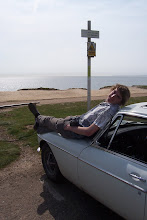 The hefty double backbone chassis being taken back to clean steel. Triumph constructed these beautifully, the arc welding is very precise and clean.
The hefty double backbone chassis being taken back to clean steel. Triumph constructed these beautifully, the arc welding is very precise and clean.To protect it, I settled for nothing less than Tetrosyl black chassis paint, which I had used previously and found to be just about the best paint available. Matt got on with applying three coats to every part of the chassis, with more in the difficult corners where mud and water collect. After a day of drying, the paint was hard enough to allow reassembly to commence, although this paint takes a long time to completely harden (a few couple of months really, but it dries quick enough to handle and assemble in the same time as most paints do) but once it is dry, it is incredibly strong and impact-resistant. The black chassis paint on the MG is still in perfect condition after a year of hard use, and bearing in mind the MG is a rally and trials machine it sees plenty of fords, mud, snow and grit. It is superbly glossy as well, and looks great when dry. It is a bit prone to running though, so care is needed. It brushes on very well, and does not leave brush marks. It can also be sprayed, I have done this on a couple of things and it worked equally well. It is far, far superior to the common option from DIY shops, (the one with a hitting tool in the name) which has poor resistance to chemicals, impact and does not stop rust occurring beneath it, due to the safety restrictions on the content it is now a poor performer. The Tetrosyl chassis paint, however, gets around these regulations by being branded “For professional use only” and is hard to find. This is true with all the best materials, those which are most difficult to get hold of, (due to safety regulations on their contents) are the ones which are most effective at protecting and lasting.
The front and rear suspension, differential and steering rack were then inspected. The steering rack had no play in it whatsoever, and other than new gaiters was left original. The front springs were in very good order as well, so these could be reused. The dampers were replaced, and a new set of rear dampers were bought at the same time. New bushes had been fitted all round, including for the anti-roll bar, which is the larger size from the Mk.IV. The vertical links were in good order, and the trunnions had been replaced shortly before the car was taken off the road for restoration, however they were fitted with new nylon bushings. New wheel bearings were fitted to the front hubs.
At the back, the reconditioned differential needed no work, and the recently replaced rear spring was still perfect, although it was stripped, repainted and rebuilt with new interleaving rubbers to give the correct ride height at the back. The rear driveshafts had recent replacement universal joints, the bearings were also sound so they were left alone.
Matt and I set to work with the fiddly job of cleaning up all the metal components which were going to be reused, ready for their coats of Tetrosyl chassis paint. The new dampers were painted in an awful low-quality black paint of the sort which only lasts a few months, so they were repainted as well. The freshly painted parts were joined by the new components we had bought, and put alongside the chassis ready for reassembly.
 The chassis has recieved yet another coat along with all the suspension parts. To give all that a coat takes 5 hours or so, and two coats are needed, on the topsides and the undersides...
The chassis has recieved yet another coat along with all the suspension parts. To give all that a coat takes 5 hours or so, and two coats are needed, on the topsides and the undersides...


No comments:
Post a Comment